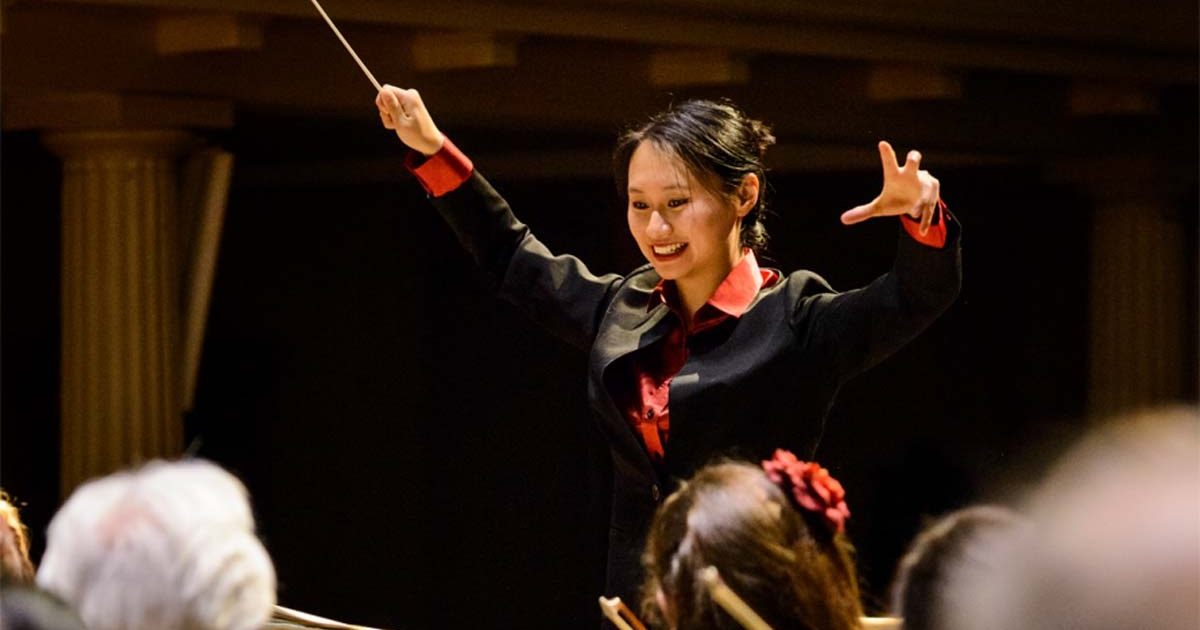The Seattle Symphony’s performance on September 29 was one of those times where the bold combination of widely contrasting musical styles ended unexpectedly with satisfying results.
At first glance, pairing a contemporary orchestral work by the prolific Finnish composer Kaija Saariaho, noted for her seriously dense tonal clusters, next to Maurice Ravel’s playful and glitteringly transparent piano concerto, and topping it all off with one of Pyotr Tchaikovsky’s gloriously brash wall-of-sound symphonies, would appear to be a clear case of incompatible concert bedfellows. But under the taut leadership of conductor Tianyi Lu this seemingly quixotic program proved to be successfully coherent, flowing from one distinct genre to the next with effortless exhilaration.
Opening the concert with the most recently composed work, Saariaho’s Ciel d’hiver (2013), was an unexpected joy mixed with sad reflection. While the news of Saariaho’s death last year from cancer at age 70 sent a shock through the music world, programming of her large body of work has been disappointingly sporadic. I have long admired her mesmerizing opera L’Amour de loin since its premiere in 2000 and have hoped Seattle Opera might present it one day. Since that day has not yet come, local audiences are at least fortunate to have heard this haunting fragment from her larger three-moment work Orion (2002.
Saariaho’s Ciel d’hiver, compared to her more electronic-mixed musique concrète compositions, is a relatively more traditional sounding orchestral work. It’s a “soundscape” work that evokes an icy picture of her Finnish homeland through stark melodies that rise out of a thick cushion of undulating strings. It has a hypnotic, impressionistic quality that in less experienced hands can turn soporific. (Indeed, scanning the audience nearby I noticed a good number of closed eyes during its performance.)
Fortunately, Lu’s clean beat and clear cues for solo entries kept this elusive music sharply focused while allowing its impressionistic imagery just enough freedom to flow freely along. Moreover, the string miasmas never obscured the important solo lines. Thus, the rustic edginess of Jeffrey Barker’s flute solos, Valerie Muzzolini Gordon’s harp cascades, and Li-Tan Hsu’s piano punctuations emerged as aptly chilling wintry echoes. It is forbiddingly atmospheric music and this beautifully bleak performance enhanced the sad knowledge of Saariaho’s recent passing.
While Saariaho’s style has often been compared, even by herself, to the great French impressionist, having her brooding Ciel d’hiver followed by Ravel’s insistently jaunty and emphatically entertaining Piano Concerto in G Major was a jarring emotional change of gears. It was also a refreshing lift out of Saariaho’s chilly celestial Nordic sky to Ravel’s jazzy urban vibes.
What unites the Ravel work is the need for crystalline precision in its orchestral and solo textures. The piano soloist Alexandra Dariescu was an ideal choice. Dariescu’s command of Ravel’s monstrous pianistic demands was brilliant and thrillingly assured, especially in the delicate hand-over-hand passages at the opening and the cascading chords and runs of the frenetic finale. Dariescu was also deft at the loose, bluesy passages which meshed beautifully with the lovely and languid Gershwinesque “Rhaposody in Blue” riffs of Ben Lulich’s clarinet solos.
Particularly exciting was Dariescu’s extraordinary coordination with Lu’s direction where the perilously rapid chord punctuations between piano and orchestra landed together with stunning precision. Where the performance faltered was in Ravel’s exquisitely simple, Satie-like opening to the second movement, a melancholy three-minute waltz solo that Ravel himself said nearly killed him to compose. Dariescu played it with significant poise, but was a bit too cool, missing a whiff of its wistful gentleness. That impression was enhanced by Lu’s bringing in the orchestra a little too tersely where Ravel clearly asks for a gentle nudge.
It was this occasional need for respites of humor and elegance that distracted from Lu’s exceptionally vivid rendition of Tchaikovsky’s Symphony No. 4. There was much to praise about the Seattle Symphony’s brass section, from the gleam of the opening “fate” motif, and the joyful buoyancy of the hunting horn calls, to the aggressive vitality of the brash final pages. The string pizzicati of the third movement had both satisfying clarity and warmth.
Yet here and there Lu could have brought a few more touches of elegance to the folk elements of the second movement’s plaintive oboe theme and comic swagger to the woodwind “drunken peasant” flourishes in the third. Still, Lu’s tense, true con fuoco pace in the final rondo made for an exhilarating ride. She kept the manic scurrying in the strings and winds in the final pages clean and tight, with the percussion bashes (for once) never overpowering this densely orchestrated wall of sound. For all the sound and fury that is usually unleashed in the final changes, Lu captured that elusive sense of Tchaikovskian nobility.
Discover more from Post Alley
Subscribe to get the latest posts sent to your email.
